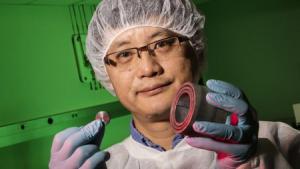Nuclear detectionNew X-ray method could detect nuclear materials
Inspectors need tools to help find nuclear materials hidden behind thick shielding or smuggled inside any of the 100 million-plus cargo containers shipped around the world each year. Uranium is perhaps the easiest nuclear material to obtain and hide. Physicists have demonstrated that their unconventional laser-based X-ray machine could provide a new defense against nuclear terrorism. The scientists used the laser-driven X-ray source to produce an image of a uranium disk no bigger than a stack of three nickels and hidden between 3-inch steel panels.

Device detected the uranium disc in the steel container, as shown // Source: unl.edu
Physicists at the Diocles Extreme Light Laboratory at the University of Nebraska-Lincoln have demonstrated that their unconventional laser-based X-ray machine could provide a new defense against nuclear terrorism.
In proof-of-principle experiments, the UNL scientists used the laser-driven X-ray source to produce an image of a uranium disk no bigger than a stack of three nickels and hidden between 3-inch steel panels.
“For the first time, we have used our new X-ray source to detect a nuclear material inside a shielded container,” said Donald Umstadter, director of the Diocles Laboratory and leader of the project.
UNL notes that the Domestic Nuclear Detection Office of the Department of Homeland Security funds the research, through a contract with the National Strategic Research Institute. The government is evaluating the technology.
Inspectors need tools to help find nuclear materials hidden behind thick shielding or smuggled inside any of the 100 million-plus cargo containers shipped around the world each year. Uranium is perhaps the easiest nuclear material to obtain and hide, Umstadter said.
The researchers demonstrated that laser-produced X-rays can detect an even smaller amount of uranium than the minimum amount required by current inspection standards (one kilogram) and can penetrate much thicker steel than the walls of cargo containers.
The laser X-ray source offers a number of advantages. Much like a laser pointer can be directed across a large auditorium, the technology can shoot a thin X-ray beam long distances, enabling inspection of cargo ships before they reach port. Yet it emits much lower levels of radiation than conventional X-rays, making it safer for use around workers and bystanders.
Unlike previous sources of similar X-rays, which require stadium-sized facilities, this X-ray source is portable and could be moved in a semi-trailer truck, increasing its potential for use as a nuclear site inspection tool.
Umstadter and his team announced in 2013 they had developed the laser-driven X-ray source, called a laser-wakefield-accelerator-driven inverse-Compton-scattering, or LWFA-ICS, source. At the time, they said the new source not only would increase the availability of sophisticated forms of X-rays needed for physics research, but it could be used to detect hidden or smuggled nuclear materials. Since then, Umstadter and his team have set about proving that the X-ray machine would work for those purposes.
“It’s not unusual for scientists to go beyond basic research to develop new technologies, as we did with our device,” he said. “However, the great urgency and importance of detecting smuggled nuclear materials compelled us to go even further and be the first to apply the new technology.”
UNL holds a patent on the new detection method, Umstadter said. The University of Michigan’s Department of Nuclear Engineering and Radiological Sciences provided numerical simulation support as a subcontractor on the project.
UNL says that the next step in this project for Umstadter and his team is to improve the performance of the X-ray device as well as the precision with which it can identify shielded nuclear materials.
Umstadter and Shouyuan Chen, a UNL research assistant professor of physics and astronomy, presented their findings at the International Meeting on Laser-Driven Radiation Sources for Nuclear Applications at George Washington University in Washington, D.C., on 15 December.
— Read more in Shouyuan Chen et al., “Shielded radiography with a laser-driven MeV-energy X-ray source,” Nuclear Instruments and Methods in Physics Research, B: Beam Interactions with Materials and Atoms 366 (1 January 2016): 217-23 (doi:10.1016/j.nimb.2015.11.007)
